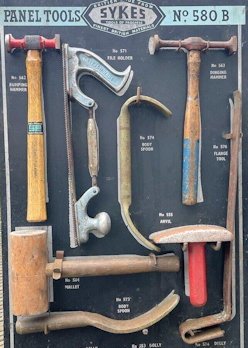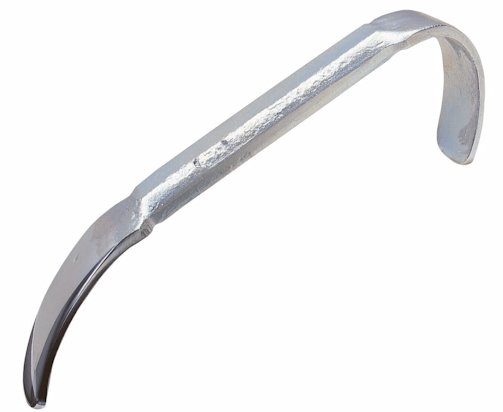Panel beating spoon Types

Panel beating spoon Spoon types and their applications.
Spoons are used for bumping and prying; they are also used in place of dollies when direct access to the rear of the panel is obstructed by the internal frame structure.
The choice of the spoon for a particular job will depend on the original contour of the metal, the amount of access, the proposed action (roughing or levelling) and the general shape and length of the spoon.
General-purpose spoon

The reshaping of the roof panel may be possible using a general-purpose spoon instead of the curved dolly.
The use of a backing piece prevents local damage prying upwards with a steady force, accompanied with external beating on any ridges that may be present, will restore the shape. Provided that a backing piece is employed, a certain amount of prying fore and aft may assist the work.

Heavy-duty pry spoon
This spoon can be used for separating outer panels from the inner frame structure when they have been damaged and squeezed together. The spoon can be driven between the plates prying sideways or up and down until the desired amount of separation is achieved. The blade can then be used as a dolly to dress out the outer panel and the inner structure, if required. The blade is reduced to a very thin section which can be used for opening door panel flanges or breaking spot-welded joints that have been previously drilled through the panel or section to be discarded.
High-crown spoon
The high-crown spoon with its broad working surface and high crown is an ideal tool as a dolly or as a spoon for work in confined areas such as headlamp housings and high-crown sections of the body.
Spring-beating spoon
This is a light pressed-steel spoon designed especially for spring-beating on ridges. The spoon is placed directly on the ridge and sharp blows with a beater are delivered to the back of the spoon, spreading the force over a large area. In this manner marking of the panel is prevented and the damage is corrected in many cases without injury to the paintwork. The intensity of the blows should be closely controlled so that the area is not forced down below its normal position. This spoon is not made for
prying or levering. Its surface as with other panel tools should be kept clean and highly polished. Any irregularities on the surface will
be reproduced on the panel in the reverse order.
